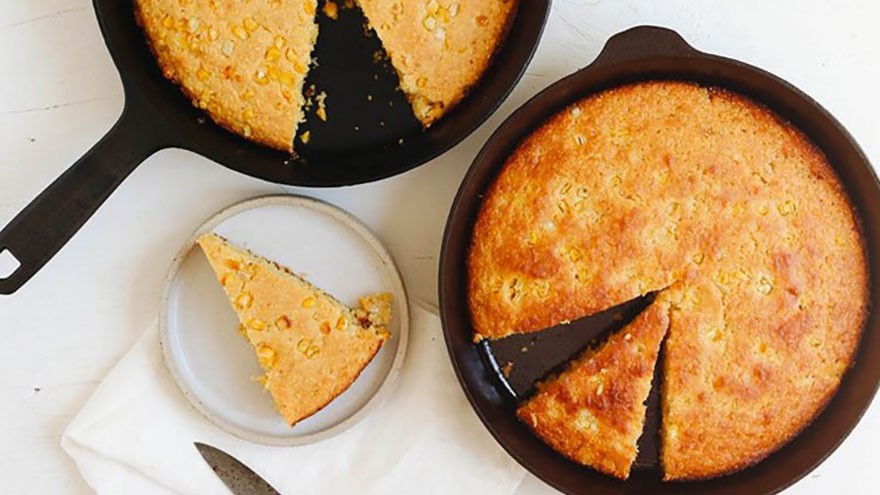Cooking with Cast Iron
There many reasons cooks love cast iron pans. Cast iron is an excellent conductor of heat, heating consistently and evenly. It also goes from stove to oven, you can use cooking tools or utensils of any materials on it, and it cleans easily. Too, a decent cast iron pan will last for generations.
Cooking with cast iron also has health benefits, since a well-seasoned pan requires no butters or oils to prevent food from sticking, and the pan itself adds iron to your diet in a day and age where iron deficiencies are common.
How to Buy Cast Iron
Cast iron pans can be purchased new, but cheap ones are often of inferior quality. Look for a pan that’s heavy in the hand – or purchase a vintage cast iron pan.
As long as it doesn’t have cracks or chips, it can be cleaned up and used.

Before Using
New cast iron cookware has a protective coating on it. This must be removed before using the pans. Scrub it off with a steel wool scouring pad, dish soap, and hot water. Pat dry with paper towels, then finish drying the pan by placing it on a warm burner for about a minute.
Old cast iron pans may require some attention, too. If they have rusty areas, scrub them with steel wool and soap. Dry as you would a new cast iron pan.
Seasoning
The biggest mistake cooks make with cast iron cookware is not seasoning it properly. This results in food that sticks to the pan. Once properly seasoned, nothing should stick to a cast iron pan.
Begin by selecting a source of oil. Vegetable oil, shortening (like Cisco), or lard are the best choices. Using a paper towel, spread a thin coat of the oil all over the interior of the pan. Place the pan on a warm burner for a minute or two. If excess oil pools in the pan, wipe it away with a paper towel. Remove pan from the heat.

Alternatively, you may place the oil-coated pan upside down in a 300 degree oven, over a baking sheet lined with foil. Heat the pan for about 30 minutes, then allow it to come to room temperature.
Repeating the seasoning process makes the pan even more non-stick.
Tips for Cooking with Cast Iron
Remember to use pot holders when handling cast iron cookware.
Always slowly preheat cast iron cookware before placing food in it. You’ll know it’s ready to cook when you sprinkle a tiny amount of water in the pan and it sizzles. If the water evaporates immediately, the pan is too hot for cooking. If the water bubbles in the pan, it’s not hot enough for cooking.
Never place cold liquids in very hot cast iron pans; this will cause the pan to crack.

If using an electric range, it’s best to cook over medium and low settings.
Acidic foods like tomatoes will look darker after cooking them in cast iron. This is because they cause more iron to leach from the pan. This is normal and safe, according to The Journal of the American Dietetic Association.
How to Clean and Maintain Cast Iron
Traditionally, cast iron pans were rarely washed. Once they were well seasoned, cooks just scraped them with a metal spatula. But unless you use your cast iron pans several times a day, every day, the oil in the pan will go rancid, creating a health hazard. This is why it’s important to wash the pan with soap and water.
To wash a cast iron pan, first allow it to cool after cooking. Wash the pan with dish soap and warm water. Don’t soak the pan. Rinse well and pat dry with paper towels.

Place the pan on a warm burner for about a minute, or until it’s thoroughly dry. While the pan is still warm, add a very light coat of oil, lard, or shortening, spreading it around with a paper towel.
Let the pan sit for a couple more minutes, then remove it from the heat and allow it to cool. If any excess oil pools in the pan, wipe it away with a paper towel.
How to Store Cast Iron
If your cast iron cookware has a lid, store it separately. Otherwise, moisture may build up in the cookware, causing rust.
It’s also a good idea to place paper towels inside cast iron cookware while it’s being stored; this will help soak up any moisture that might be present.
Check out the video version of this article on YouTube

